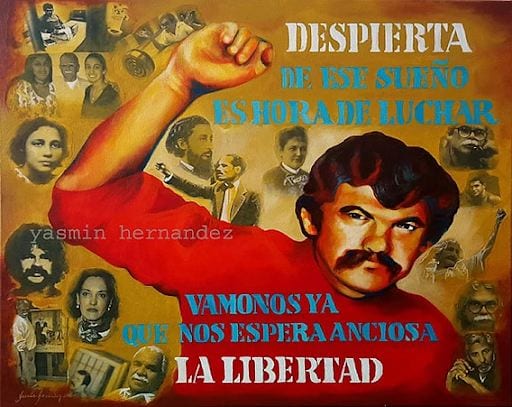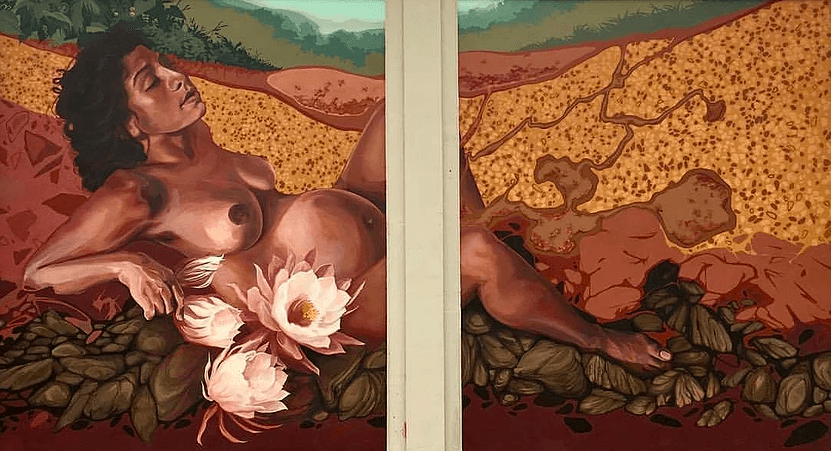The theme of my quote collection is empowering language as a tool to both foster self-awareness and create coalition. Each quote is laid over a symbol or piece of land that relates to the author or topic because one of the most powerful points that has been impressed on me in this course and these readings is that decolonization cannot be divorced from land.
I know that some of the symbols I used aren’t perfect. Some of the maps I used aren’t as precise as they should be. I did the best I could, not with the goal of perfection, but with helping myself to better link author with culture with land. And the process of creating those visuals was helpful for me. If nothing else, it shows the far-reaching extent of not only colonization, but more importantly, the decolonial theorists who rose up independently but went on to forge powerful international coalition.
I’m a white AFAB nonbinary lesbian with a car and a job and a year left to go on my degree. It’s important for me to acknowledge that I do have a lot of privilege and that I therefore lack perspective that the voices who shape this course write about. And it’s especially important for me to study writers because before I am anything else, I am a writer, too. But I write about gay mermaids and all I really want is a career writing about gay mermaids. It sounds silly, but I am 100% serious in saying it’s my whole life. As a lesbian, having seen myself in [very few] characters only to watch them die horrible deaths at an alarming rate compared to straight characters, I know that this is a problem other marginalized groups face as well, so I write diverse gay mer-heroines. Mermaids can and do come from anywhere and any-when. I try to write gay mermaids who are whole people, who are like me and unlike me in any way I can think of, who have experiences that have never been seen in a superhero backstory, but this class helped me realize where I can do better.
A while ago, I mentioned that the Lugones quote about dropping “enchantment with ‘woman,’ the universal” is probably the most profound quote of the semester for me for a personal reason. The reason is that it has caused me to re-conceptualize how I approach my own art. Gender is nuanced and means different things to different people in different cultures. A few months ago, because of this class, I started to slowly begin a process of decolonizing the Undine Isles (the home of the gay mermaids–can you decolonize a fictional place? I’m gonna go ahead and say yes) because my perhaps unattainable but no less worthwhile goal is that any reader should feel safe there. That’s what the entire project has always been about. This class made my personal art more of what I want and need it to be, so thank you to Dr. P and everyone for helping and being with me on this journey.
WORKS CITED
- Lugones, M. (2010). Toward a Decolonial Feminism. In Hypatia (Vol. 25, Ser. 4, p. 753). Hypatia.
- Gunn Allen, P. (n.d.). Some like Indians Endure. In Making Face, Making Soul: Haciendo Caras: Creative and Critical Perspectives by Feminists of Color (pp. 298-299).
- Anzaldúa, G. (1980). Borderlands: La Frontera. San Francisco, CA: Aunt Lute Books.
- Pérez, E. (2006, October). Queer Subaltern Citizens: Agency through Decolonial Queer Theory: Subaltern Citizens and their Histories [PDF].
- Lugones, M. (1987). Playfulness, “World”-Travelling, and Loving Perception. Hypatia (Vol. 2, Ser. 2).
- Chrystos. (n.d.). Those Tears. In Resist racism and eat your carrots. Retrieved from https://resistracism.wordpress.com/2008/05/21/those-tears/
- Aizura et al. Introduction. Decolonizing the Trans Imaginary. (2014). Duke University Press. (Reprinted from TSQ: Transgender Studies Quarterly, 1(3), (2014))
- Levins Morales, A. (n.d.). Declaracion. Retrieved May 2, 2019, from http://www.auroralevinsmorales.com/declaracion.html
- Levins Morales, A. (1998). Remedios. limited edition 2019 [PDF].
- Young Lords Party, The. (n.d.). 13-Point Program and Platform. In University of Virginia. Retrieved May 2, 2019, from http://www2.iath.virginia.edu/sixties/HTML_docs/Resources/Primary/Manifestos/Young_Lords_platform.html The Sixties Project, University of Virginia
#decolonization #fpod #feminism #indigenousfeminisms #puertoricanfeminisms
















